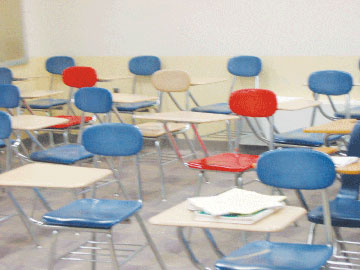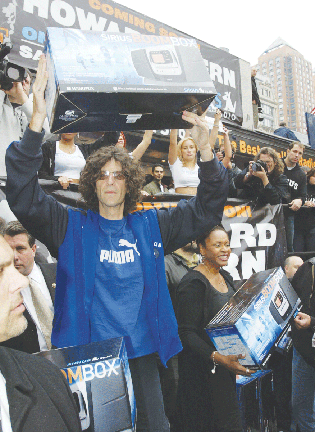NEASC Self-Study Draft in Discussion
October 7, 2004
UMass Boston administration officials are soliciting input from the campus community on a recently released self-study of university services and departments.
The self-study, in preparation for the impending New England Association of Schools and Colleges (NEASC) evaluation in April 2005, comes in at a printer-busting 110 pages.
“We’re asking anyone to send comments to myself or Celia Moore,” said Peter Langer, the associate provost who, along with Moore, a psychology professor, is co-chair of the NEASC Self-Study Steering Committee. The deadline for comments is October 15.
Asked if there are any suggestions to make the draft shorter, Langer laughs, adding that the first draft was nearly 150 pages. “We really cut it down,” he said.
“It’s not going to be much less than 100 pages,” he said. “In order to cover the 12 standards, you can’t spend much less than 10 pages on each one.”
The twelve standards, for which there will each be a NEASC evaluator, range from faculty, student services, financial resources, to integrity.
“You want to give a lot of evidence, you want to give a lot of meat,” he said. “We have a lot of say.”
The draft, currently up on the university’s website for community review, goes through the various services in detail, such as whether credits are given towards graduation for pre-college courses. “If you don’t address them, then [the NEASC evaluation team is] going to have to find it out by themselves when they come for the visit, so you put it in the self-study so they don’t have to go digging around,” he said. “So that’s why you can’t write a twenty-page self-study.”
Initial feedback from NEASC on the first draft has been positive. The head of the NEASC evaluation team, Cleveland State University Michael Schwartz, had seen an earlier copy and made comments on it. The team will be made up of members from peer institutions, of colleges like UMass Boston. Names have not been confirmed as of yet, though a list of team members has been submitted to Chancellor Keith Motley for perusal and to avoid a conflicts of interest.
“What NEASC does, it pulls together a group of reviewers, who are fellow academics, professors, and administrators and staff who are our peers, to review what we do,” said Langer, a veteran of NEASC evaluation teams himself. “The review team will be primarily people from other public institutions. And in order for it to be objective, none of them are from Massachusetts.”
The team is expected to stay at a nearby hotel from April 10 to April 13, and tour the campus and its facilities, interviewing and talking with campus groups.
“The self-study is critical, because from NEASC’s point of view, every campus has different issues, and the self-study is an opportunity for the campus to assess how it’s proceeding in its self-defined goals,” Langer said. “The self-study is actually the most important part of the accreditation, because when the team comes in April, what they are charged with doing is essentially verifying the self-study.”
If problems aren’t raised in the report, and the NEASC team comes on campus and finds the problems, a concern will arise of whether the campus has been candid. “The self-study meant to acknowledge strengths and identify areas where we could do a better job,” said Langer.
The self-study, for which each standard had a group of administrators, faculty, and staff composing its section, worked over the summer and produced a draft in early September. Nearly 100 people participated in all, though the group is looking for more participation in discussing the draft. Langer says he has already met with the undergraduate student Senate and the Graduate Student Assembly for feedback from students. The self-study group now has a self-imposed deadline of the end of December to get the final draft finished. “We could wait until the middle of February,” Langer said, but they want to get it in early.
The last time a major self-study was done was ten years ago, at the time of the last NEASC evaluation. “Things have changed because we now have concerns and issues that we may not have had ten years ago,” Langer said.
The long-term capital improvement plan and infrastructure is one example. “We’re very concerned about over the next ten years how we’re going to take care of deferred maintenance, and issues such as the upper level and lower level infrastructure of the whole campus,” he said. “When asked to address the standards of physical resources, we say we are concerned about the physical infrastructure and we have a ten-year plan to address it. So that’s something we’re highlighting.”
The aim is to get the university re-accredited. The university’s evaluation is “critically important,” according to Langer. “If your degree is going to mean anything, you want to come to an accredited institution. If UMass Boston were to lose its accreditation, your degree wouldn’t be worth the paper it’s printed on.”
The Boston campus would also lose its shots at Pell grants and other financial aid. “If we were to lose our accreditation, it would be a terrible blow to students,” Langer said.
But there is little to fear here. Since the university is doing a “good job,” it can be expected to get its accreditation renewed, according to Langer. Most schools that lose their accreditation can blame it on severe financial difficulties or legal problems. Large universities like UMass Boston can face serious sanctions, or get a provisional accreditation, where the NEASC team returns in two years expecting major problems to be fixed.
For now, six months away from the team’s visit, Langer is looking for comment from the greater campus community. “I’m just trying to get broad participation,” he said.






















































